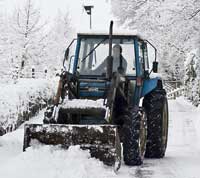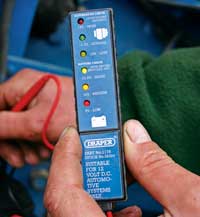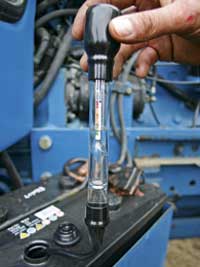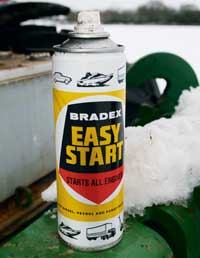Keep your machinery running smoothly in freezing weather

FUEL
1 Winter diesel starts being delivered on 1 October and should stop waxing down to -12C. However if you still have summer-delivered diesel in the tank as well, the mix is obviously more likely to wax up than neat winter diesel, come the cold weather.
2 One answer is to use an anti-waxing additive. However, it won’t dissolve existing wax deposits so you need to add it when temperatures are above freezing. Kamco is one of several firms who offer products; its Waxbreaker Gold costs £29.40 for five litres, which is enough to treat 5000 litres of diesel.
3 Your tractor dealer may well be able to supply a fuel pre-heater. John Deere, for example has one that uses a heating element in the filter at low temperatures. It also offers a mains-powered coolant heater that warms the coolant water to 50C – so no cold tractor engines and much reduced wear.
4 Owners of older tractors sometimes add small quantities of kerosene to their diesel to reduce its chances of waxing. It’s something that has to be done with considerable care (and with full knowledge of the possible consequences) we’d suggest. It’s also apparently illegal to mix fuels…
5 Keep vehicle tanks as full as possible to avoid condensation build-up and subsequent starting issues. If possible brim the tank when the machine has just finished work – that way it’ll be warm and water vapour won’t have a chance to condense in the full tank.
BATTERIES
 6 Either invest in a cheap multimeter (about £15) or a simple LED-type battery/alternator tester (£15) and with the engine running check the output of the alternator – it should run at between 12V to 14V. Then, with the engine stopped, check battery output which should hold somewhere above 12V.
6 Either invest in a cheap multimeter (about £15) or a simple LED-type battery/alternator tester (£15) and with the engine running check the output of the alternator – it should run at between 12V to 14V. Then, with the engine stopped, check battery output which should hold somewhere above 12V.
 7 If things don’t seem right in this department get hold of a float-type hydrometer (£6) to test the battery electrolyte and thus its ability to hold charge. Before testing it, check the fluid level in each of the cells and top up with distilled water. Then run the engine for a short while to get a uniform charge across all cells.
7 If things don’t seem right in this department get hold of a float-type hydrometer (£6) to test the battery electrolyte and thus its ability to hold charge. Before testing it, check the fluid level in each of the cells and top up with distilled water. Then run the engine for a short while to get a uniform charge across all cells.
 8 If there are issues with charging and starting take a good look at all the wiring between battery, alternator and starter-motor. Make sure all the main terminals get a good smearing of copper grease and the remaining wiring and connectors are liberally hosed down with a water-repellant aerosol spray (ideally silicone-based).
8 If there are issues with charging and starting take a good look at all the wiring between battery, alternator and starter-motor. Make sure all the main terminals get a good smearing of copper grease and the remaining wiring and connectors are liberally hosed down with a water-repellant aerosol spray (ideally silicone-based).
COOLANT
9 The damage done by a lack of anti-freeze in coolant can signal the end for an engine. A simple float-type tester (£5-£10) will show the concentration of glycol or ethylene in coolant. Minimum mix should be 40% to give protection down to -24C.
FUEL PRE-HEATERS
10 Older, non-common-rail engines will have a single heater plug with a fuel supply fitted to the intake manifold. With the ignition in the cold-start position, a valve opens and as fuel is drawn through it is heated and vaporises, making starting easier.
With someone in the cab holding the ignition in the heat position, disconnect the wiring and check the current with a test-lamp or multi-meter.
11 If it is sound move on to the plug itself. Loosen it from the manifold and, ensuring it is earthed, get your assistant to set it to heat again.
The coiled element should glow red and a constant stream of fuel vapour should be clearly visible. If not, the problem is likely to be the plug which usually costs between £40-£60 to replace.
Modern, electronically-governed common-rail engines will have individual heater-plugs for each cylinder. Checking they are operational is a dealer laptop job but an error-code should appear on the dash if something is awry.
 12 Some tractors – typically larger, American-built six-cylinders – have an ether injection system to ease starting in cold conditions. Usually supplied by aerosol-type canister, refills should be available from main dealers.
12 Some tractors – typically larger, American-built six-cylinders – have an ether injection system to ease starting in cold conditions. Usually supplied by aerosol-type canister, refills should be available from main dealers.
13 Only use Easy-Start as a last resort.
TYRES
14 If you are out on the roads clearing snow, gritting or just helping free stranded cars, consider how best to widen your tractor tyre footprint. So long as you stick to low speed work then dropping tyre pressure is the best way to achieve this.
15 However, remember that they need to be re-inflated before you run back up to top speed or start shifting heavy loads.
16 With 4x4s stick with the vehicle’s standard recommended tyre pressures and remember that a narrower wheel will be more effective at cutting into snow or ice and maintaining traction.
WORKSHOP
17 Quartz halogen heaters heat only solid objects and not the air around them. This makes them ideal in a workshop where they can be directed onto the machine being worked on without wasting energy heating the whole shed. They’re available from most workshop suppliers like Spaldings, Screwfix and Machine Mart, Prices start at £200.
18 Waste oil heaterscan be used so long as you are only burning oils produced on-site and the heater output does not exceed 0.4MW. These will typically set you back anything from £800 upwards.
PIPES
19 Heat tape (or heat cable) is long strips of heating elements that can be wrapped round water pipes to apply heat directly to the water supply. Some have thermostats to turn them off in warmer weather. Prices range from around £10/m and it’s available from several companies, including TLC Direct

